New Insights in the Nanomechanical Study of Carbon-Containing Nanocomposite Materials Based on High-Density Polyethylene
Abstract
1. Introduction
2. Materials and Methods
2.1. Materials
2.2. Preparation of Nanocomposite Specimens
| Carbon Nanofiller | Diameter | Length | Purity | Aspect Ratio | Average Thickness | Specific Surface Area (SSA) | Volume Resistivity |
|---|---|---|---|---|---|---|---|
| MWCNTs (NC7000) | 9.5 nm (OD) | 1.5 μm | 90% | 150 | − | 250–300 m2/g | 10−4 Ω.cm |
| TNGNPs | 5−10 μm | − | 99.5% | 500 | 4–20 nm | − | 4 × 10−4 Ω.cm |
2.3. Instrumental Methods
3. Results and Discussion
3.1. Quasi-Static Nanoindentation

3.2. Nanoscratch Testing
3.3. Thermal Conductivity Measurements
3.4. Nanocomposite Electrical Properties
3.5. Scanning Electron Microscopy Analysis
4. Conclusions
Supplementary Materials
Author Contributions
Funding
Data Availability Statement
Conflicts of Interest
References
- Kumar, A.; Sharma, K.; Dixit, A.R. Carbon nanotube- and graphene-reinforced multiphase polymeric composites: Review on their properties and applications. J. Mater. Sci. 2020, 55, 2682–2724. [Google Scholar] [CrossRef]
- Mohan, S.; Olley, R.H.; Vaughan, A.S.; Mitchell, G.R. Evaluating Scales of Structures. In Controlling the Morphology of Polymers; Mitchell, G., Tojeira, A., Eds.; Springer: Cham, Switzerland, 2016; pp. 29–67. [Google Scholar]
- Hossain, M.I.; Chowdhury, M.A.; Mahamud, S.; Saha, R.K.; Zahid, M.S.; Ferdous, J.; Hossain, N.; Mobarak, M.H. Electro-mechanical analysis of nanostructured polymer matrix composite materials for 3D printing using machine learning. Chem. Eng. J. Adv. 2024, 19, 100626. [Google Scholar] [CrossRef]
- Desnoes, E.; Deshaies, P.; Bideau, B.; Rubiano, J. Thermoformed products from high-density polyethylene and Softwood kraft pulp. Nord. Pulp. Pap. Res. J. 2024, 39, 339–348. [Google Scholar] [CrossRef]
- Kadhim, B.J.; Mahdi, A.H.; Al-Mutairi, N.H. Mechanical and Thermal Properties of PP/HDPE Blends Reinforced with ZnO Nanoparticles for Industrial Applications. Int. J. Nanoelectron. Mater. 2024, 17, 479–486. [Google Scholar] [CrossRef]
- Sahu, S.K.; Badgayan, N.D.; Samanta, S.; Rama Sreekanth, P.S. Quasistatic and dynamic nanomechanical properties of HDPE reinforced with 0/1/2 dimensional carbon nanofillers based hybrid nanocomposite using nanoindentation. Mat. Chem. Phys. 2018, 203, 173–184. [Google Scholar] [CrossRef]
- Rajeshwari, P.; Rao, V.V.; Dey, T.K. Depth-Sensing Indentation and Nano-Dynamic Mechanical Properties of Aluminum Nitride Nanoparticles Reinforced High Density Poly-Ethylene Nanocomposites. Polym. Compos. 2017, 40, 240–254. [Google Scholar] [CrossRef]
- Rajeshwari, P.; Dey, T.K. Novel HDPE nanocomposites containing aluminum nitride (nano) particles: Micro-structural and nano-mechanical properties correlation. Mat. Chem. Phys. 2017, 190, 175–186. [Google Scholar] [CrossRef]
- Rajeshwari, P. Kinetic analysis of the non-isothermal degradation of high density polyethylene filled with multi-wall carbon nanotubes. J. Therm. Anal. Calorim. 2016, 123, 1523–1544. [Google Scholar] [CrossRef]
- Mohammadi, M.; Ziaie, F.; Majdabadi, A.; Akhavan, A.; Shafaei, M. Improvement of mechanical and thermal properties of high energy electron beam irradiated HDPE/hydroxyapatite nano-composite. Radiat. Phys. Chem. 2017, 130, 229–235. [Google Scholar] [CrossRef]
- Bajwa, D.S.; Chanda, S.; Ryan, C.; Bajwa, S.G.; Stark, N.; Matteson, K. Graphene quantum dots/cellulose nanocrystal inclusion complex for enhancing the physical and thermal properties of HDPE polymer matrix. Carbohydr. Polym. Technol. Appl. 2024, 7, 100450. [Google Scholar] [CrossRef]
- Li, H.-X.; Russell, T.P.; Wang, D. Nanomechanical and Chemical Mapping of the Structure and Interfacial Properties in Immiscible Ternary Polymer Systems. Chin. J. Polym. Sci. 2021, 39, 651–658. [Google Scholar] [CrossRef]
- Hosoya, R.; Morita, H.; Nakajima, K. Analysis of Nanomechanical Properties of Polyethylene Using Molecular Dynamics Simulation. Macromolecules 2020, 53, 6163–6172. [Google Scholar] [CrossRef]
- Al Rez, M.F.; Alothman, O.Y.; Fouad, H.; Mahmood, A.; Alfotawi, R.; Ansari, S.G.; Fouad, M.; Hashem, M.; Al-Jassir, F.F. Stromal Cells Attachment, Proliferation and Nano-Mechanical Behavior of High Density Polyethylene/Carbon Nanotubes/Nanoclay as Artificial Hip and Knee Joint Bearing Material. Nanosci. Nanotechnol. Lett. 2016, 8, 846–852. [Google Scholar] [CrossRef]
- Sreekanth, P.S.R.; Kanagaraj, S. Assessment of bulk and surface properties of medical grade UHMWPE based nanocomposites using Nanoindentation and microtensile testing. J. Mech. Behav. Biomed. 2013, 18, 140–151. [Google Scholar] [CrossRef] [PubMed]
- Badgayan, N.D.; Samanta, S.; Sahu, S.K.; Siva, S.B.V.; Sadasivuni, K.K.; Sahu, D.; Sreekanth, P.S.R. Tribological behaviour of 1D and 2D nanofiller based high density polyethylene hybrid nanocomposites: A run-in and steady state phase analysis. Wear 2017, 376–377, 1379–1390. [Google Scholar] [CrossRef]
- Han, C.-S. Influence of the molecular structure on indentation size effect in polymers. Mater. Sci. Eng. A 2010, 527, 619–624. [Google Scholar] [CrossRef]
- Han, C.S.; Sanei, S.H.R.; Alisafaei, F. On the origin of indentation size effects and depth dependent mechanical properties of elastic polymers. J. Polym. Eng. 2016, 36, 103–111. [Google Scholar] [CrossRef]
- Batakliev, T.; Ivanov, E.; Angelov, V.; Spinelli, G.; Kotsilkova, R. Advanced Nanomechanical Characterization of Biopolymer Films Containing GNPs and MWCNTs in Hybrid Composite Structure. Nanomaterials 2022, 12, 709. [Google Scholar] [CrossRef]
- Tantry, S.; Anantharaman, D.; Thimmappa, B.H.S.; Kamalakaran, R. Studying banded spherulites in HDPE by electron microscopy. Polym. Test. 2020, 89, 106631. [Google Scholar] [CrossRef]
- Oliver, W.C.; Pharr, G.M. An Improved Technique for Determining Hardness and Elastic Modulus Using Load and Displacement Sensing Indentation Experiments. J. Mater. Res. 1992, 7, 1564–1583. [Google Scholar] [CrossRef]
- Batakliev, T.; Georgiev, V.; Angelov, V.; Ivanov, E.; Kalupgian, C.; Muñoz, P.A.R.; Fechine, G.J.M.; Andrade, R.J.E.; Kotsilkova, R. Synergistic Effect of Graphene Nanoplatelets and Multiwall Carbon Nanotubes Incorporated in PLA Matrix: Nanoindentation of Composites with Improved Mechanical Properties. J. Mater. Eng. Perform. 2021, 30, 3822–3830. [Google Scholar] [CrossRef]
- Alisafaei, F.; Han, C.-S.; Lakhera, N. Characterization of indentation size effects in epoxy. Polym. Test. 2014, 40, 70–78. [Google Scholar] [CrossRef]
- Peng, C.; Zeng, F. Modeling the indentation size effects of polymers, based on couple stress elasticity and shear transformation plasticity. Arch. Appl. Mech. 2022, 92, 3661–3681. [Google Scholar] [CrossRef]
- Badgayan, N.D.; Sahu, S.K.; Samanta, S.; Sreekanth, P.S.R. An insight into mechanical properties of polymer nanocomposites reinforced with multidimensional filler system: A state of art review. Mater. Today Proc. 2020, 24, 422–431. [Google Scholar] [CrossRef]
- Mallikarjunachari, G.; Ghosh, P. Analysis of strength and response of polymer nano thin film interfaces applying nanoindentation and nanoscratch techniques. Polymer 2016, 90, 53–66. [Google Scholar] [CrossRef]
- Briscoe, B.J.; Fiori, L.; Pelillo, E. Nano-indentation of polymeric surfaces. J. Phys. D Appl. Phys. 1998, 31, 2395–2405. [Google Scholar] [CrossRef]
- Shen, L.; Phang, I.Y.; Liu, T.; Zeng, K. Nanoindentation and morphological studies on nylon 66/organoclay nanocomposites. II. Effect of strain rate. Polymer 2004, 45, 8221–8229. [Google Scholar] [CrossRef]
- Tserpes, K.I.; Chanteli, A.; Pantelakis, S.; Koumoulos, E.P.; Charitidis, C.A. Mechanical and nanomechanical properties of MWCNT/PP nanocomposite. Frat. Ed Integrità Strutt. 2018, 12, 73–83. [Google Scholar] [CrossRef]
- Koumoulos, E.P.; Jagadale, P.; Lorenzi, A.; Tagliaferro, A.; Charitidis, C.A. Evaluation of surface properties of epoxy-nanodiamonds composites. Compos. B Eng. 2015, 80, 27–36. [Google Scholar] [CrossRef]
- Shokrieh, M.M.; Hosseinkhani, M.R.; Naimi-Jamal, M.R.; Tourani, H. Nanoindentation and Nanoscratch Investigations on Graphene—Based Nanocomposites. Polym. Test. 2013, 32, 45–51. [Google Scholar] [CrossRef]
- Gibson, R.F. A review of recent research on nanoindentation of polymer composites and their constituents. Compos. Sci. Technol. 2014, 105, 51–65. [Google Scholar] [CrossRef]
- Mallikarjunachari, G.; Ghosh, P. Pile-up response of polymer thin films to static and dynamic loading. Thin Solid Films 2019, 677, 1–12. [Google Scholar] [CrossRef]
- Wang, Z.; Gu, P.; Zhang, H.; Zhang, Z.; Wu, X. Indenter geometrical effects on sub-micro/nano indentation and scratch behaviors of polymeric surfaces. Mech. Adv. Mater. Struct. 2016, 23, 291–300. [Google Scholar] [CrossRef]
- Li, A.; Zhang, C.; Zhang, Y.F. Thermal conductivity of graphene-polymer composites: Mechanisms, properties, and applications. Polymers 2017, 9, 437. [Google Scholar] [CrossRef]
- Balandin, A. Thermal properties of graphene and nanostructured carbon materials. Nature Mater. 2011, 10, 569–581. [Google Scholar] [CrossRef]
- Tarani, E.; Terzopoulou, Z.; Bikiaris, D.N.; Kyratsi, T.; Chrissafis, K.; Vourlias, G. Thermal conductivity and degradation behavior of HDPE/graphene nanocomposites. J. Therm. Anal. Calorim. 2017, 129, 1715–1726. [Google Scholar] [CrossRef]
- Kotsilkova, R.; Ivanov, E.; Georgiev, V.; Ivanova, R.; Menseidov, D.; Batakliev, T.; Angelov, V.; Xia, H.; Chen, Y.; Bychanok, D.; et al. Essential Nanostructure Parameters to Govern Reinforcement and Functionality of Poly(lactic) Acid Nanocomposites with Graphene and Carbon Nanotubes for 3D Printing Application. Polymers 2020, 12, 1208. [Google Scholar] [CrossRef]
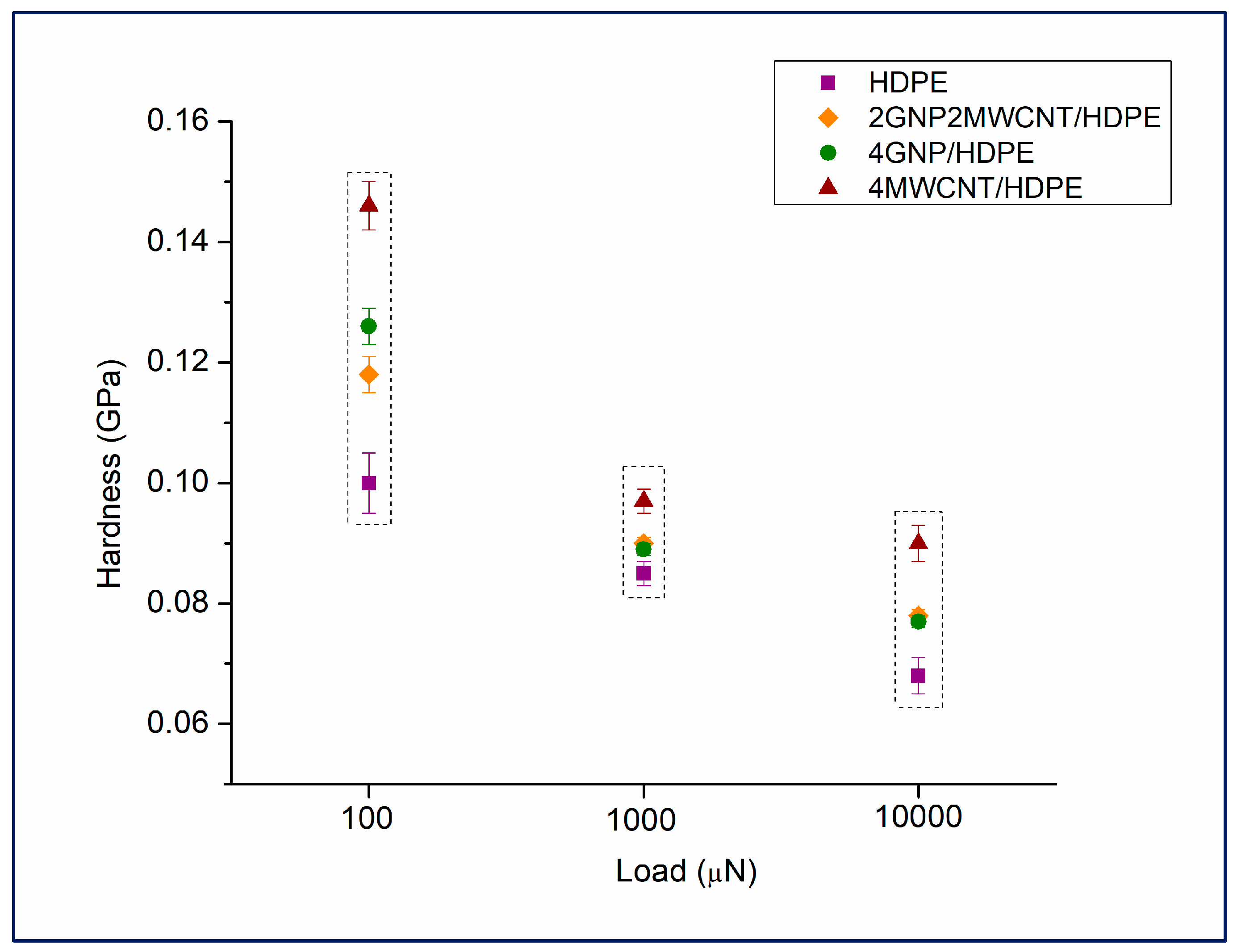
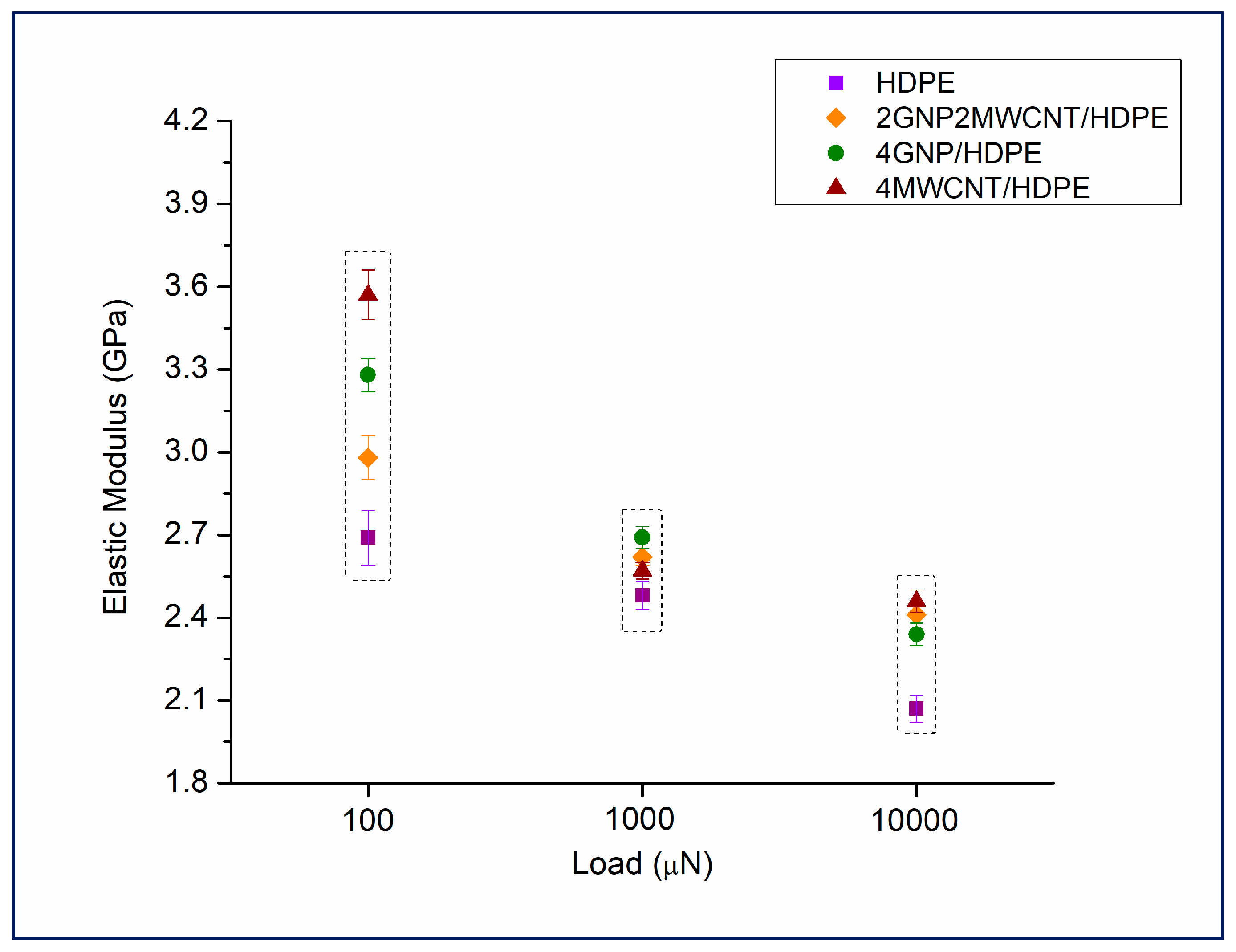
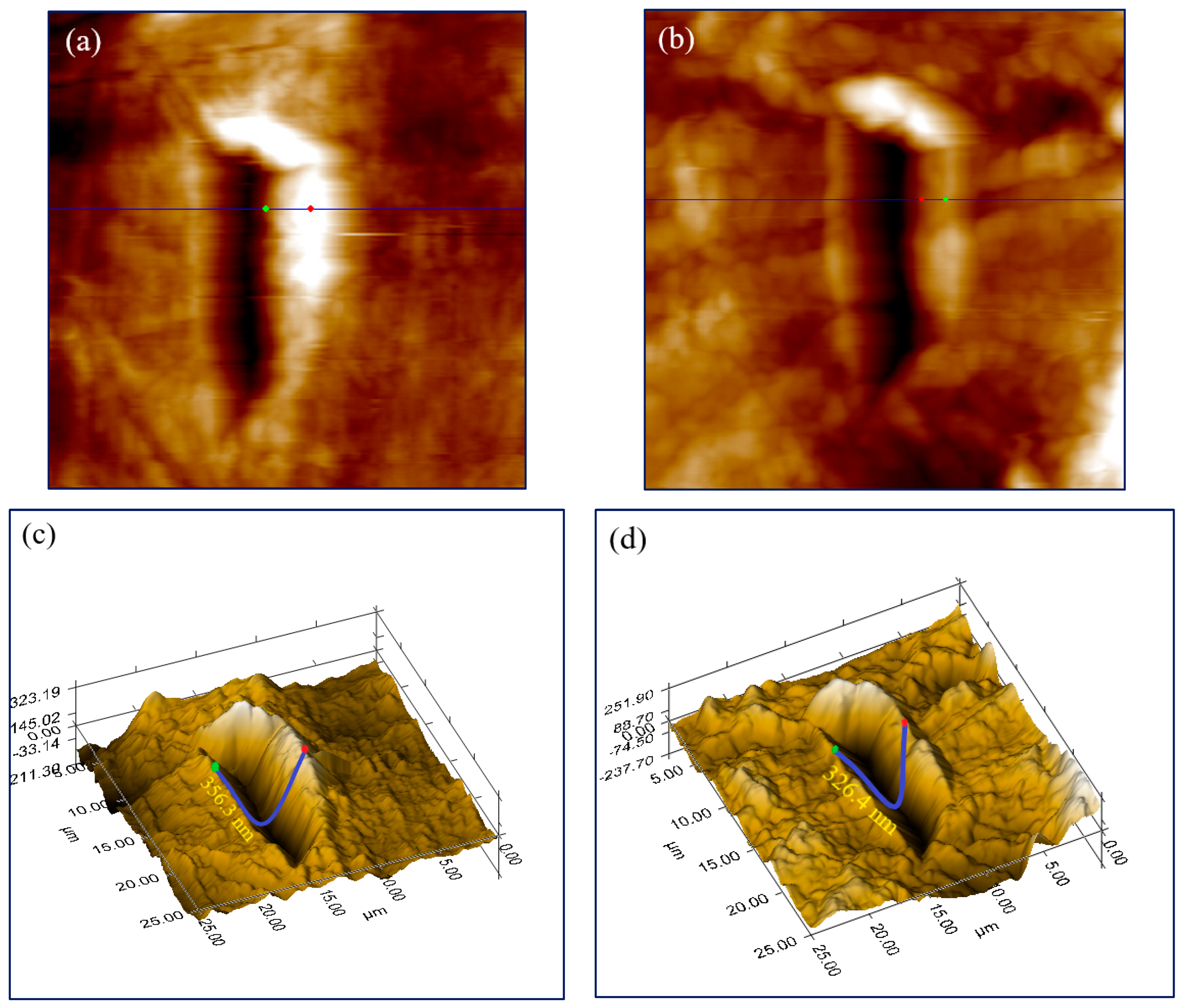
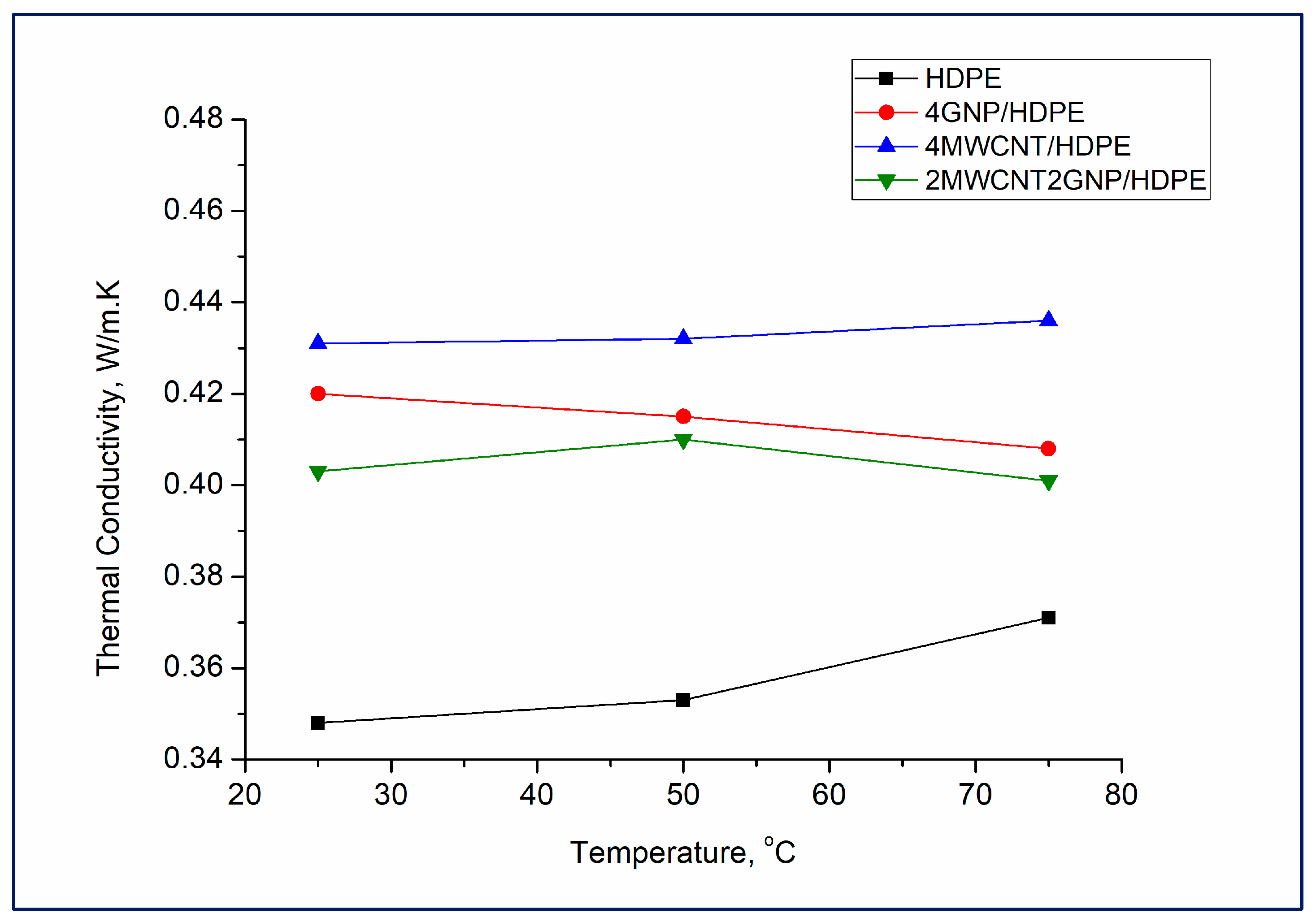
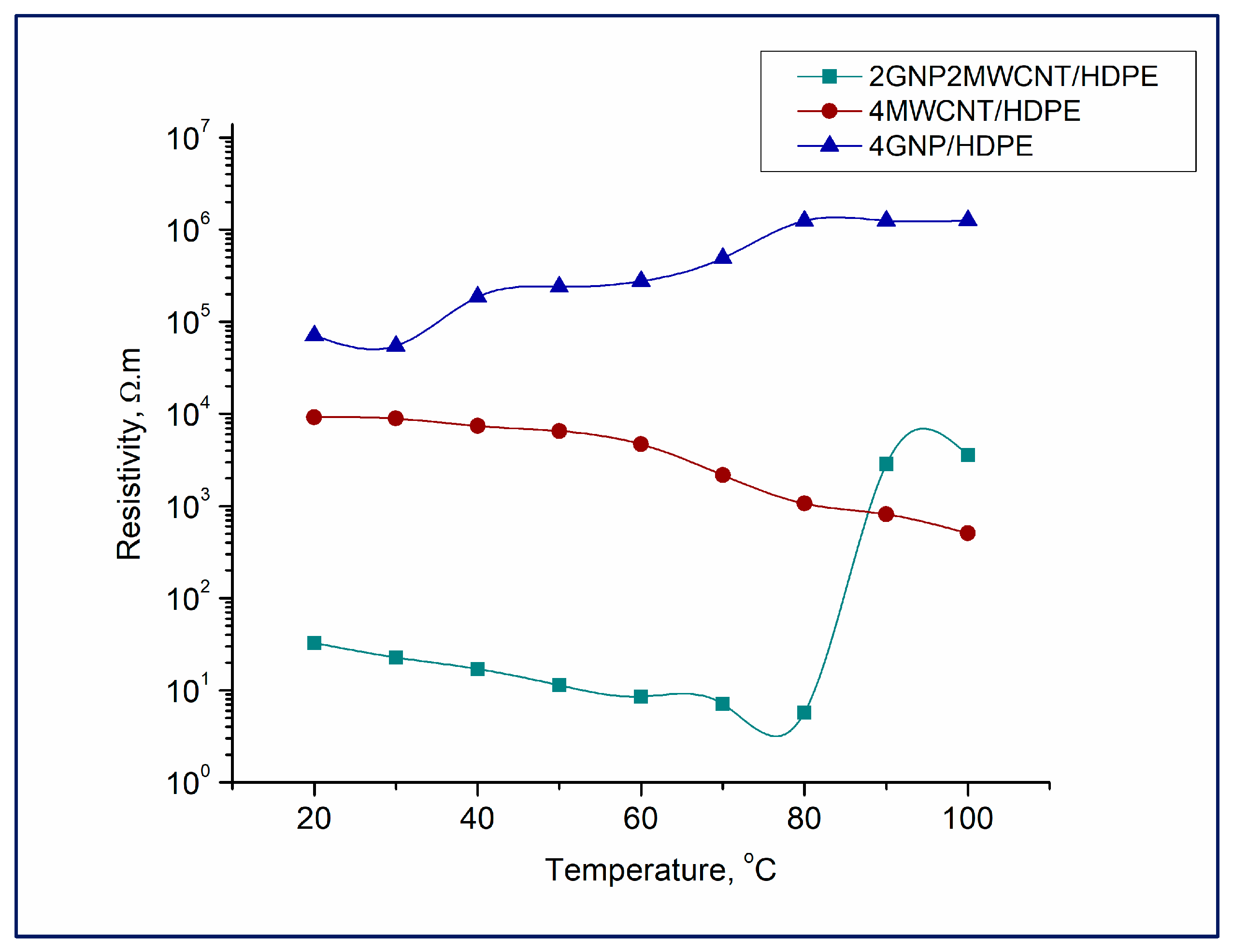

| Sample | Contact Depth [nm] at 100 μN Peak Load | Contact Depth [nm] at 1000 μN Peak Load | Contact Depth [nm] at 10,000 μN Peak Load |
|---|---|---|---|
| HDPE | 179 ± 10 | 662 ± 35 | 2411 ± 67 |
| 4wt%GNP/HDPE | 159 ± 19 | 657 ± 77 | 2280 ± 86 |
| 4wt%MWCNT/HDPE | 149 ± 22 | 622 ± 46 | 2104 ± 118 |
| 2wt%GNP2wt%MWCNT/HDPE | 166 ± 23 | 651 ± 52 | 2269 ± 157 |
| Sample | H/E at 100 μN Peak Load | H/E at 1000 μN Peak Load | H/E at 10,000 μN Peak Load |
|---|---|---|---|
| HDPE | 0.037 | 0.034 | 0.033 |
| 4wt%GNP/HDPE | 0.038 | 0.033 | 0.033 |
| 4wt%MWCNT/HDPE | 0.040 | 0.038 | 0.037 |
| 2wt%GNP2wt%MWCNT/HDPE | 0.040 | 0.034 | 0.032 |
| Composite Sample | COF (Fx/Fz) | Lateral Pile-Up (nm) | Average Surface Roughness (nm) |
|---|---|---|---|
| HDPE | 0.332 | 243.9 | 17.5 |
| 4wt%GNP/HDPE | 0.401 | 221.6 | 24.1 |
| 4wt%MWCNT/HDPE | 0.343 | 133.1 | 29.6 |
| 2wt%GNP2wt%MWCNT/HDPE | 0.344 | 73.7 | 18.4 |
Disclaimer/Publisher’s Note: The statements, opinions and data contained in all publications are solely those of the individual author(s) and contributor(s) and not of MDPI and/or the editor(s). MDPI and/or the editor(s) disclaim responsibility for any injury to people or property resulting from any ideas, methods, instructions or products referred to in the content. |
© 2024 by the authors. Licensee MDPI, Basel, Switzerland. This article is an open access article distributed under the terms and conditions of the Creative Commons Attribution (CC BY) license (https://creativecommons.org/licenses/by/4.0/).
Share and Cite
Batakliev, T.; Ivanov, E.; Georgiev, V.; Angelov, V.; Ahuir-Torres, J.I.; Harvey, D.M.; Kotsilkova, R. New Insights in the Nanomechanical Study of Carbon-Containing Nanocomposite Materials Based on High-Density Polyethylene. Appl. Sci. 2024, 14, 9961. https://doi.org/10.3390/app14219961
Batakliev T, Ivanov E, Georgiev V, Angelov V, Ahuir-Torres JI, Harvey DM, Kotsilkova R. New Insights in the Nanomechanical Study of Carbon-Containing Nanocomposite Materials Based on High-Density Polyethylene. Applied Sciences. 2024; 14(21):9961. https://doi.org/10.3390/app14219961
Chicago/Turabian StyleBatakliev, Todor, Evgeni Ivanov, Vladimir Georgiev, Verislav Angelov, Juan Ignacio Ahuir-Torres, David Mark Harvey, and Rumiana Kotsilkova. 2024. "New Insights in the Nanomechanical Study of Carbon-Containing Nanocomposite Materials Based on High-Density Polyethylene" Applied Sciences 14, no. 21: 9961. https://doi.org/10.3390/app14219961
APA StyleBatakliev, T., Ivanov, E., Georgiev, V., Angelov, V., Ahuir-Torres, J. I., Harvey, D. M., & Kotsilkova, R. (2024). New Insights in the Nanomechanical Study of Carbon-Containing Nanocomposite Materials Based on High-Density Polyethylene. Applied Sciences, 14(21), 9961. https://doi.org/10.3390/app14219961








